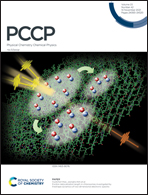A first-principles study of two-dimensional NbSe2H/g-ZnO van der Waals heterostructures as a water splitting photocatalyst†
Abstract
Based on first-principles calculations, we propose a new two-dimensional (2D) van der Waals (vdW) heterostructure that can be used as a photocatalyst for water splitting. The heterostructure consists of vertically stacked 2D NbSe2H and graphene-like ZnO (g-ZnO). Depending on the stacking orders, we identified two configurations that have high binding energies with an energy band gap of >2.6 eV. These 2D systems form a type-II heterostructure which enables the separation of photoexcited electrons and holes. The presence of a strong electrostatic potential difference across the 2D NbSe2H and g-ZnO interface is expected to suppress the electron–hole recombination leading to an enhancement in the efficiency of the photocatalytic activity. Our study also shows that the 2D NbSe2H/g-ZnO vdW heterostructure has good thermodynamic properties for water splitting. Furthermore, the optical absorption of the 2D NbSe2H/g-ZnO vdW heterostructure extends into the visible light region. Our results suggest that the 2D NbSe2H/g-ZnO vdW heterostructure is a promising photocatalytic material for water splitting.



 Please wait while we load your content...
Please wait while we load your content...